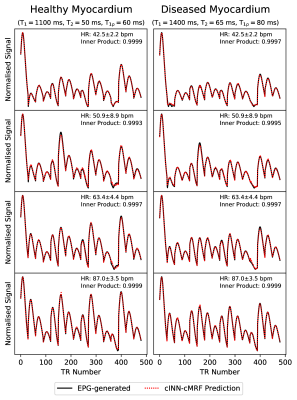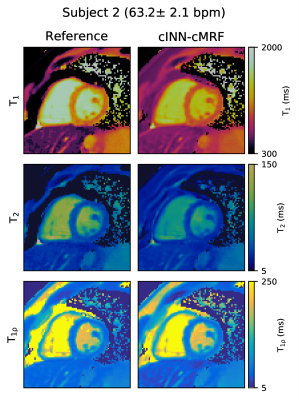1760
Dictionary Generation and Matching with Conditional Invertible Neural Networks for Cardiac MR Fingerprinting
Thomas James Fletcher1, Carlos Velasco1, Gastão Cruz1, Alina Schneider1, René Michael Botnar1, and Claudia Prieto1
1School of Biomedical Engineering and Imaging Sciences, King's College London, London, United Kingdom
1School of Biomedical Engineering and Imaging Sciences, King's College London, London, United Kingdom
Synopsis
Dictionary generation and pattern matching are two important bottlenecks in cardiac MRF. Dictionaries must be recalculated for each new scan as they depend on the subject’s heart rate variability and both dictionaries and the length of pattern matching grow exponentially with the number of parameters being considered. We propose a conditional invertible neural network capable of both dictionary generation and parameter estimation for T1, T2 and T1ρ cardiac MRF. The network achieves excellent results on EPG-generated data (inner product >0.999, parameters’ relative error <1.5%) and good results for in-vivo data (mean relative errors for myocardium ranging from 2.2% to 15.1%).
Introduction
Cardiac Magnetic Resonance Fingerprinting (MRF) has been proposed to rapidly and simultaneously quantify multiple tissue parameters including T1 and T2 1-3. More recently simultaneous T1, T2 and T1ρ cardiac MRF4 has been introduced and has enabled promising detection of focal and diffuse myocardial fibrosis with T1ρ without the need of exogenous contrast agents. However, the computational burden of MRF dictionary generation and pattern matching increases exponentially with the number of parameters. This is especially challenging for cardiac MRF that requires subject-specific dictionaries incorporating information about heart rate variability throughout the scan. Here we use invertible neural networks5, which learn both the well-defined forward process and the often-ambiguous inverse process using the same invertible network. We build upon previous work applying invertible neural networks to MRF targeting skeletal muscle6, extending it here to cardiac MRF where subject-specific heart rates must also be considered. The proposed approach can rapidly generate accurate cardiac MRF dictionaries and provide accurate parameter estimation for a wide range of heart rates and heart rate variability. The proposed approach is evaluated on EPG-generated dictionaries and in-vivo data.Methods
The proposed conditional invertible neural network for cardiac MRF (cINN-cMRF) consists of 8 invertible affine GLOW7 coupling blocks, each followed by random invertible permutations. Each invertible block contains a feedforward neural network with an input and output layer and 3 hidden layers of 480 neurons. The network is trained and evaluated in both the forward and backward directions, corresponding to dictionary generation and dictionary matching respectively (Fig. 1). The inputs for the INN in the forward direction are the T1, T2 and T1ρ values ($$$x$$$) and the condition ($$$c$$$), 15 RR intervals for the 16-heartbeat acquisition. The network outputs a 480-element vector ($$$\hat{y}$$$), corresponding to the absolute values of the fingerprint. When the network is reversed, the fingerprint ($$$y$$$) and RRs ($$$c$$$) are input and a prediction for the parameters ($$$\hat{x}$$$) is output.Training data for the neural network was generated using EPG8 simulations. Dictionaries were generated using RR sequences derived from patient scans, to simulate realistic heart rate variability. In total, 1056 unique RR sequences were obtained. Dictionaries with 34680 T1, T2 and T1ρ combinations and associated fingerprints were generated for each of these RR sequences, resulting in 36.6 million unique combinations of $$$x$$$, $$$y$$$ and $$$c$$$. The network was trained and evaluated with a 60:30:10 train, validation, test split. The network is constructed using the FrEIA9 package and written in PyTorch.
The proposed approach was tested using test data from EPG simulations to compare the predictions of the invertible network for both fingerprint generation and parameter estimation. In addition, the parameter estimation of the network was evaluated using time point MRF images from undersampled reconstructed in-vivo data. Acquisitions were performed on a 1.5T scanner (Ingenia, Philips Healthcare) on 10 healthy subjects, using a novel 2D cardiac MRF sequence based on inversion recovery, T2 preparation (echo times T2pTEs = {0, 40, 80 ms}) and T1ρ preparation (spin lock times SLTs = {0, 40, 80 ms} at 350 Hz) pulses4. Relevant acquisition parameters included: 30 spiral readouts per heartbeat, sinusoidally varying FA of 5-10deg, TE/TR= 0.91/7.11 ms, scan time ~16s.
Results
Fingerprints generated by the proposed cINN-cMRF for healthy (T1 = 1100 ms, T2 = 50 ms and T1ρ = 60 ms) and diseased (T1 = 1400 ms, T2 = 65 ms and T1ρ = 80 ms) myocardium are shown in Figure 2 for four different RR sequences. The cINN-cMRF provides excellent predictions, with the inner product between the predicted and EPG-generated fingerprints ranging from 0.9993 to 0.9999. A dictionary with 140400 parameter combinations takes 6.7 seconds to compute with the cINN-cMRF compared to ~15 minutes using EPG simulations (>130 times faster).The relative error of predicted parameters for the same RR sequences and healthy and diseased myocardium are shown in Figure 3. Again, the cINN-cMRF provides excellent predictions, with the relative error of predicted parameters ranging from 0.1% to 1.4%.
T1, T2 and T1ρ cardiac MRF maps generated by the cINN-cMRF using MRF images from partially reconstructed data as input are compared to maps generated using an exhaustive search of the EPG dictionary in Figures 4 and 5 for two different healthy subjects (75.4 ± 2.9 bpm and 63.2 ± 2.1 bpm). Good quality maps are obtained using the proposed approach. The mean relative errors for T1, T2 and T1ρ for the myocardium are 5.4%, 10.4% and 2.2% respectively for Subject 1 and 10.9%, 15.1% and 9.1% for Subject 2.
Conclusion
We have proposed and tested a conditional invertible neural network capable of both accurate dictionary generation, in 6.7 seconds, and parameter estimation for T1, T2, T1ρ and a wide range of heart rates and heart rate variabilities for cardiac MRF. The network has been tested on EPG-generated data (with RR sequences from patient scans) and in-vivo scans of healthy subjects. Future work will investigate the addition of a latent space to help distinguish between ambiguous cases for the inverse parameter estimation problem in undersampled acquisitions, improving the current parameter estimation in-vivo and extending the model to perform the full reconstruction by adapting the network architecture within the invertible blocks.Acknowledgements
This work was supported by the following grants: (1) EP/V044087/1, EPSRC EP/P032311/1, EP/P007619/1, EP/P001009/1; (2) BHF programme grant RG/20/1/34802, (3) Wellcome/EPSRC Centre for Medical Engineering (WT 203148/Z/16/Z) and (4) Fondecyt 1210637.References
- Hamilton, Jesse I., et al. "MR fingerprinting for rapid quantification of myocardial T1, T2, and proton spin density." Magnetic resonance in medicine 77.4 (2017): 1446-1458.
- Liu, Yuchi, et al. "Cardiac magnetic resonance fingerprinting: technical overview and initial results." JACC: Cardiovascular Imaging 11.12 (2018): 1837-1853.
- Cruz, Gastao, et al. "Cardiac magnetic resonance fingerprinting: Technical developments and initial clinical validation." Current cardiology reports 21.9 (2019): 1-10.
- Velasco, Carlos, et al. “Simultaneous T1, T2 and T1ρ Cardiac Magnetic Resonance Fingerprinting for Contrast Agent-free Myocardial Tissue Characterization”, Magnetic Resonance in Medicine, (2021) DOI:10.1002/mrm.29091.
- Ardizzone, Lynton, et al., “Analyzing inverse problems with invertible neural networks.” arXiv preprint arXiv:1808.04730 (2018).
- Balsiger, Fabian, et al., “Learning Bloch Simulations for MR Fingerprinting by Invertible Neural Networks.” International Workshop on Machine Learning for Medical Imaging Reconstruction, (2020): 60-69.
- Kingma, Diederik P., et al. “Glow: Generative Flow with Invertible 1x1 Convolutions.” arXiv preprint arXiv:1807.03039 (2018).
- Weigel, Matthias. "Extended phase graphs: dephasing, RF pulses, and echoes‐pure and simple." Journal of Magnetic Resonance Imaging 41.2 (2015): 266-295.
- Framework for Easily Invertible Architectures (FrEIA), https://github.com/VLL-HD/FrEIA.
Figures

Fig. 1: Overview of the conditional invertible neural network which is trained in both directions using EPG-generated data. Inputting MR parameters ($$$x$$$), conditioned on the RRs ($$$c$$$), results in a prediction for the fingerprint ($$$\hat{y}$$$). In the reverse direction inputting $$$y$$$ conditioned on $$$c$$$, outputs a prediction $$$\hat{x}$$$. The same network architecture is used for both the forward and backward processes, resulting in a network jointly optimised for dictionary generation (well-defined simulation) and pattern matching (inverse problem).

Fig. 2: Fingerprints predicted by the cINN-cMRF (red dotted lines) compared to reference fingerprints calculated using EPG simulations (black solid lines) for both healthy and diseased myocardium (left and right columns respectively) and a range of RR sequences taken from patient scans (corresponding to 42.5 ± 2.2 bpm, 50.9 ± 8.9 bpm, 63.4 ± 4.4 bpm, 87.0 ± 3.5 bpm). The invertible neural network provides excellent predictions for the fingerprints with the inner product ranging from 0.9993 to 0.9999.

Fig. 3: Relative error of MR parameters predicted by the cINN-cMRF using fingerprints as input, conditioned on the corresponding RR sequence for both healthy and diseased myocardium (green and purple respectively). The invertible neural network provides excellent predictions for the MR parameters with relative errors ranging from 0.1% to 1.4%.

Fig. 4: Short axis view of T1, T2 and T1ρ maps in a healthy subject with a heart rate of 75.4 ± 2.9 bpm. Reference maps generated using pattern matching, an exhaustive search of the EPG-generated dictionary (left column), are compared to the predicted maps from the cINN-cMRF using MRF images as input conditioned on the measured RR sequence. The mean relative errors for myocardium are 5.4%, 10.4% and 2.2% for T1, T2 and T1ρ respectively.

Fig. 5: Short axis view of T1, T2 and T1ρ maps in a healthy subject with a heart rate of 63.2 ± 2.1 bpm. Reference maps generated using pattern matching, an exhaustive search of the EPG-generated dictionary (left column), are compared to the predicted maps from the cINN-cMRF using MRF images as input conditioned on the measured RR sequence. The mean relative errors for myocardium are 10.9%, 15.1% and 9.1% for T1, T2 and T1ρ respectively.
DOI: https://doi.org/10.58530/2022/1760